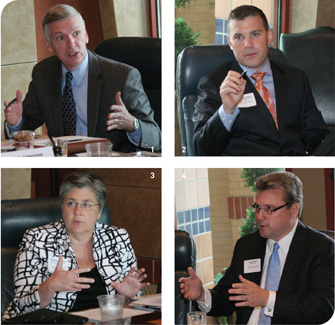
1. Ed Fensholt neatly summed up the challenge of advising clients on health-benefits structures before the regulations have been finalized: “I’m annoyed.” | 2. Matt Condon addressed the need for business executives to get out in front of enrollment issues before the crisis stage. | 3. Danette Wilson noted the business opportunities in front of Blue KC with hundreds of thousands of potential new customers in the Kansas City region. | 4. For a company with thousands of hourly workers in restaurant settings, communication on health-benefit plan changes is inordinately challenging, said Alan Salts.
“Are we enthusiastic about it?” Ryan
Huffman, senior vice president at Cohen-
Esry Real Estate Services, asked rhetorically of the ACA. “Probably not, but we do look at it as there are opportunities here.” The silver lining Huffman saw was a small shift of the health burden to the individual.
Ed Fensholt, an attorney who heads up Lockton’s compliance services group and health reform advisory practice, offered
the question’s most distinctive response. “I’m annoyed,” he said. His group’s job is to shepherd the firm’s clients through a regulatory maze, but with the regulation now stretching “from the floor to the ceiling” and with regulatory guidance really not adequately in place, there is much to be annoyed about.
Co-chair David Gentile offered still another response, and his was “disciplined.” He sees too much uncertainty and too much regulatory change to make a firm prediction about ACA’s future. “We’re getting rules sent to us on a frequent-enough basis that I can say it’s almost hourly,” said Gentile, adding, “The only way to get to a success strategy is to continue to work through all the issues and the opportunities.”
The Exchanges
After all the debate about health exchanges, the government has chan-ged their designations to “marketplace.”
Said David Gentile, “I’m going to refer to it as an exchange, because I don’t really believe it is a true marketplace.”
As Gentile explained, insurance carriers now have to provide a variety of coverages ranging from “bronze” to “platinum.” Individuals in the marketplace select a product from the exchange, and the government provides a portal for those individuals to do an assessment of cost and coverage.
Ed Fensholt said that the exchanges are really supposed to be available to those folks who are not getting an offer of reasonably good and affordable coverage from an employer. They’re the ones for whom these exchanges were designed. If they cannot afford a plan, the government subsidizes it based on household income.
If a plan is deemed affordable to an individual, said Rick Kahle, it should cost no more than 9.5 percent of the household income for the single rate. What is uncertain is whether the employer alone has the responsibility for making that determination.
The real administrative challenge, thus, is how to establish that the employers in question have not offered the employee affordable coverage. To solve this problem, said Fensholt unenthusiastically, the federal government is building a massive federal data base, the purpose of which is to connect all the elements of this massive system—every state Medicaid agency, Medicare, Homeland Security, etc.—with the IRS and the employers.
The burden, Fensholt explained, will eventually fall on the employer. After an individual gets approved for coverage on the exchange, the IRS will eventually circle back to the employer and say, “Hey, we gave federal money to an individual who says they were employed by you.” The employer will then have to prove that the individual deserved the subsidy.
Gentile asked whether employers would try to assess an employee’s eligibility for subsidies on an exchange when communicating with them about coverage options. Matt Condon is disinclined to do that. The Athletic & Rehabilitation Center has been working collaboratively with its employees to keep them on its own plan. “If you have that conversation a month before it happens, you’re done,” said Condon. “But if you have it now, we’ve got a chance to have people really understand.”